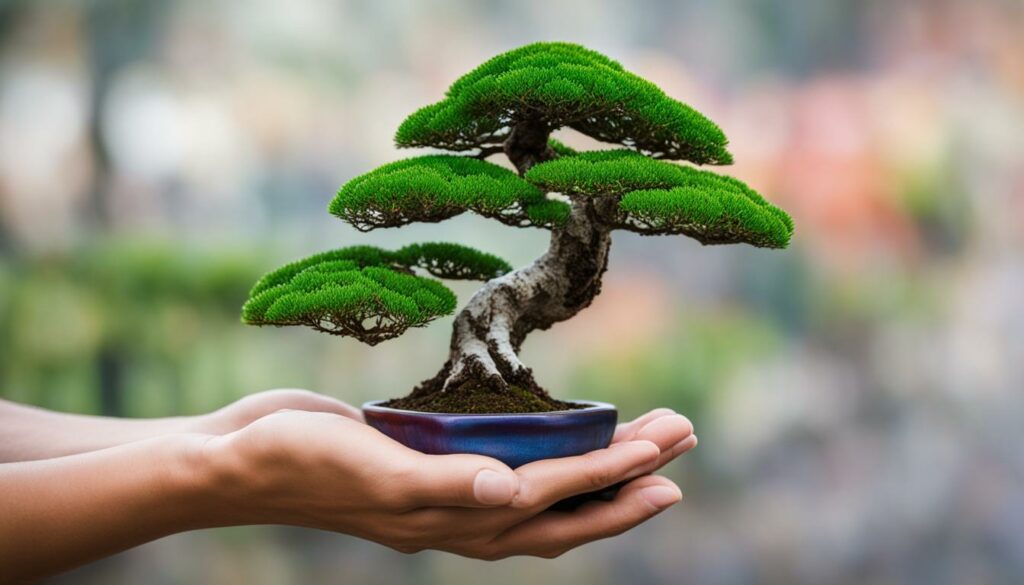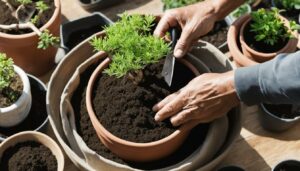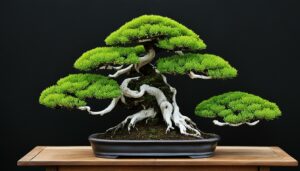If you’re looking to improve the growth and aesthetics of your bonsai trees, mastering bonsai grafting techniques is the way to go. Bonsai cultivation grafting trees is the process of joining two different trees to create a new bonsai with unique characteristics. This is done by making a cut in the tree and securing a new branch or stem into the cut. Understanding the grafting methods and tools used in bonsai cultivation can help you achieve your desired bonsai tree.
With the art of bonsai grafting, you can create a bonsai tree with improved characteristics such as increased branch density, thicker trunks, and better aesthetics. You can also strengthen the tree, increase its resistance to pests and diseases, and establish a more vigorous root system.
Discover the essentials of bonsai cultivation grafting trees and how it can take your bonsai trees to the next level. Let’s dive in and explore the world of bonsai grafting.
Key Takeaways
- Bonsai cultivation grafting trees is the joining of two trees to create a unique bonsai tree.
- Grafting can improve branch density, trunk thickness, and the overall aesthetics of a bonsai tree.
- Grafting can strengthen the tree, increase resistance to pests and diseases, and establish a more vigorous root system.
- By mastering the grafting methods and tools used in bonsai cultivation, you can create your desired bonsai tree.
- Bonsai grafting is an art form that can take your bonsai trees to the next level, creating unique and stunning specimens.
Understanding Bonsai Grafting
Bonsai cultivation grafting trees is an essential practice used to improve the growth, health, and visual aesthetics of your bonsai. Grafting involves joining a scion, or desired cutting, with the rootstock of another tree to create a seamless and thriving new tree.
There are various methods and techniques used in bonsai grafting, including side grafting, approach grafting, and whip and tongue grafting. By learning and mastering these grafting skills, you can create unique and stunning bonsai specimens.
Benefits of Bonsai Grafting
Practicing bonsai grafting has numerous benefits beyond merely aesthetic appeal. When done correctly, grafting can enhance the overall health and density of your bonsai trees.
- The process of tree joining through grafting allows you to combine the best qualities of two different trees into one, resulting in an overall stronger and more resilient bonsai.
- Bonsai improvement can also be achieved through grafting by promoting faster healing of damaged or weakened trees.
- Grafting can increase branch density, resulting in greater foliage and overall growth of your bonsai trees. It can also create unique and artistic shapes that cannot be achieved through traditional pruning techniques.
- By experimenting with different grafting techniques, you can create one-of-a-kind specimens that reflect your personal style and artistic vision.
Remember that proper care and maintenance are essential to ensuring the success of your grafted bonsai. Consider the unique needs of your particular species and consult with experts when necessary.
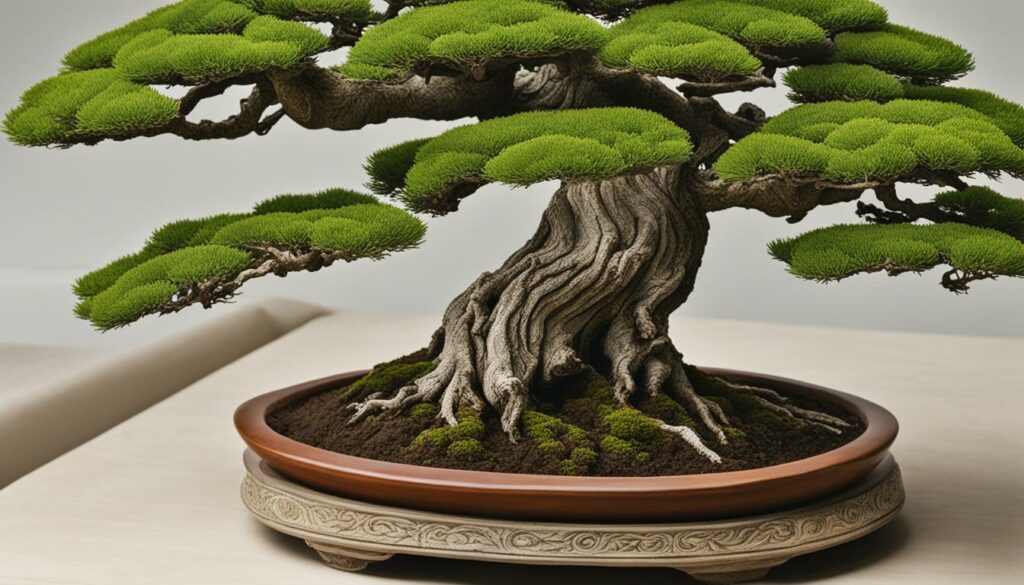
“Through grafting, you can create unique specimens that reflect your own personality and style like no other art form.”
Essential Tools for Bonsai Grafting
Proper tools are crucial for achieving successful bonsai grafting. Here are some essential tools you’ll need to equip yourself with:
| Tool | Purpose |
|---|---|
| Grafting knife | Used to make precise cuts when joining different parts of a tree |
| Budding knife | Used for bud grafting and cutting small pieces of bark |
| Pruning shears | Used to trim branches and leaves |
| Wire cutter | Used to cut wire for holding grafts in place |
| Sealant | Used to cover and protect the graft site from infections and pests |
Make sure you have all the necessary tools before attempting to graft your bonsai. This will ensure that the process is smooth and successful, and will result in improved bonsai trees.
Selecting the Right Bonsai Species for Grafting
When it comes to bonsai cultivation grafting trees, it’s important to carefully select the right species for the grafting process. Not all plants are compatible for grafting, and successful grafting requires understanding various factors related to the compatibility of the species being joined.
First of all, it’s important to evaluate the health of the plant. Be sure to select healthy species with well-developed root systems and minimal disease or pest damage. Trees with strong root systems are crucial as they will be the base for your graft, and you want them to stay healthy.
Another factor to consider is whether the plant material is from the same family or relative species. This will determine the degree of compatibility and successful grafting. The closer the genetic similarity, the higher the chances of a successful graft.
Consider the developmental stage of the plants too. Young plants tend to have more success with grafting compared to older ones. In terms of timing, it’s generally recommended to graft during the plant’s growing season to increase the survival rate of the graft.
Lastly, when picking species, consider what your end goal is. Do you want to obtain a specific look or quality in your bonsai tree? Keep your specifications in mind when selecting the species to be used for grafting.
Tip: For beginners in bonsai cultivation grafting trees, it’s recommended to start with familiar species to increase the chances of successful grafting.
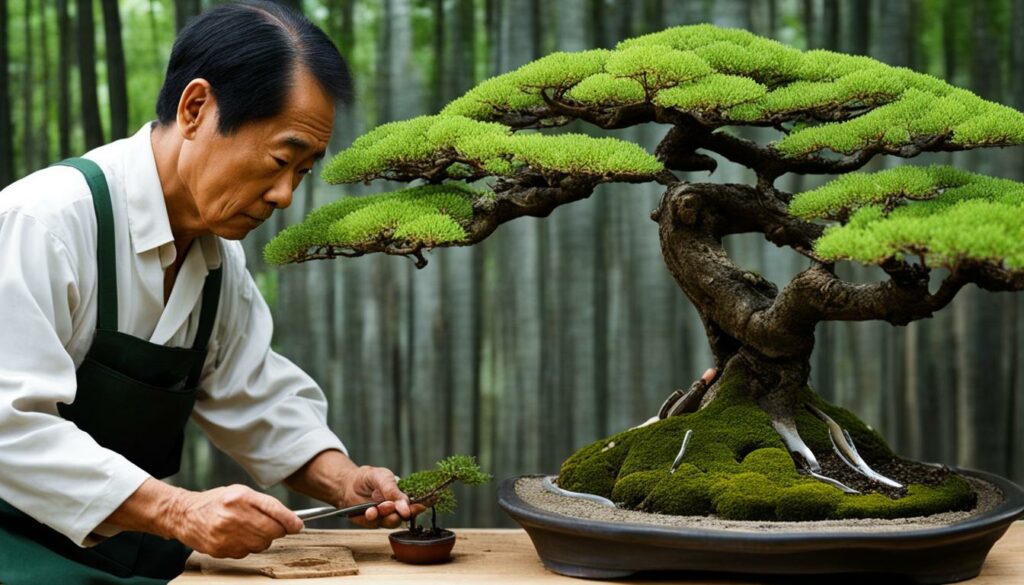
Selecting the Right Rootstock:
When selecting a rootstock, consider the following characteristics:
| Hardiness | Growth speed | Size | Disease resistance | Compatibility | |
|---|---|---|---|---|---|
| Factor | The rootstock should be hardy to prevent disease and pest infestations. | Consider the growth speed of the rootstock based on your intended outcome. Faster growth results in quicker results but also more maintenance, while slower growth means less maintenance but longer wait times. | The size of the rootstock should be proportionate to the desired bonsai end size. | The rootstock should have disease resistance to minimize the chances of infection transferring to the graft. | Make sure the rootstock and scion are compatible to ensure the success of the graft. |
Overall, the proper pairing of the plant material and rootstock will significantly increase your odds for successful bonsai cultivation grafting trees.
Preparing the Bonsai for Grafting
Before embarking on the grafting process, you must ensure that your bonsai tree is healthy and ready for the procedure. Proper preparation can help minimize the risk of stress and shock to the tree, leading to better grafting success rates and healthier, more vigorous growth.
Here are some essential preparations to make before grafting your bonsai:
- Prune the tree: Remove any dead or diseased branches, as well as any branches that may interfere with the grafting process. A well-pruned tree can help direct growth where you want it, enhancing the overall health and aesthetic appeal of your bonsai.
- Provide optimal growing conditions: Your bonsai tree must be in the ideal growing conditions to ensure maximum uptake of nutrients and water. Make sure the tree is well-watered and fertilized, and consider using a rooting hormone to help stimulate growth before grafting.
- Select the correct grafting method: Different grafting methods work better for different tree species and sizes. Ensure that the grafting technique you choose is the most suitable for your particular bonsai tree.
By taking these necessary steps, you can increase your chances of successful bonsai grafting, leading to healthier and more aesthetically pleasing trees.
Bonsai Grafting Preparation Table
| Steps to Take for Preparing the Bonsai for Grafting | Benefits of Taking these Steps |
|---|---|
| Prune the tree, removing any dead or diseased branches | Enhances overall health and aesthetic appeal of the bonsai tree |
| Provide optimal growing conditions, making sure the tree is well-watered and fertilized | Increases uptake of nutrients and water, reducing stress and risk of shock during grafting |
| Select the correct grafting method based on tree species and size | Improves the success rates of the grafting process and overall tree health |
Basic Grafting Techniques for Bonsai
Now that you have gained an understanding of bonsai grafting, it’s time to master the fundamental techniques. Proper execution of these techniques holds the key to bonsai improvement and optimal tree growth. Here are the key grafting skills to focus on:
Side grafting
Side grafting involves attaching a scion, or the refined branch of the donor plant, to a branch that is removed from the recipient plant.
Whip and Tongue Grafting
Whip and tongue grafting is a technique used to join two branches of equal diameter and create a strong, secure bond. The technique requires a precise cut, ensuring the branches join fully.
Approach Grafting
Approach grafting is a useful technique if bonsai trees have major branches that are not close enough to the trunk to graft onto. In this grafting technique, a section of bark and cambium layer is removed from the main trunk of the recipient tree, creating a flap. Then, the donor tree’s branch is inserted into the flap and taped in place until they fuse together.
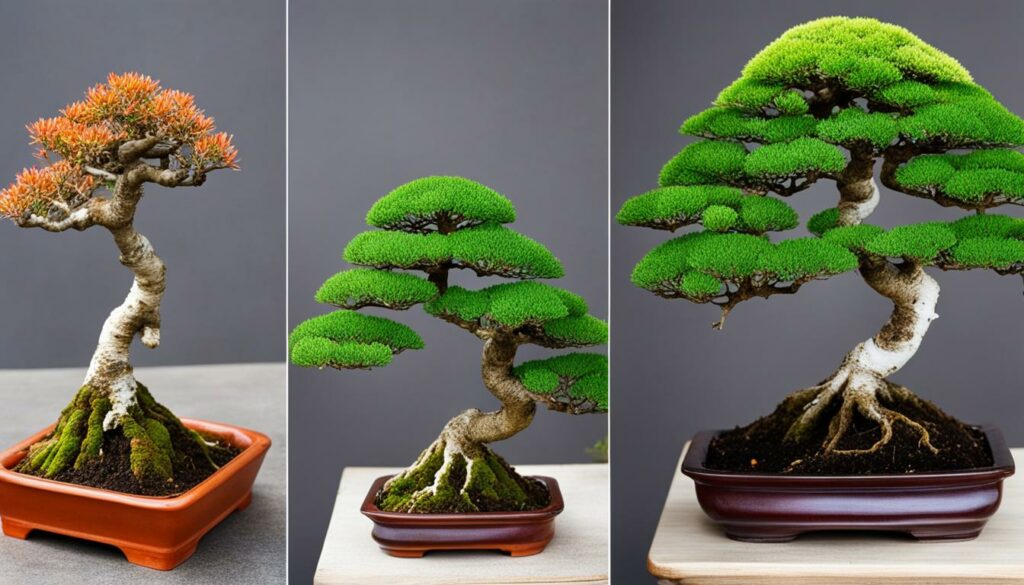
| Grafting Technique | Best Used for |
|---|---|
| Side grafting | Joining a branch to the trunk or another branch |
| Whip and Tongue Grafting | Bridging the gap between branches of equal diameter |
| Approach Grafting | Cultivating trees with inaccessible major branches for grafting |
Remember, successful bonsai cultivation grafting trees depend on prioritizing tree health, using sterile techniques, and understanding the compatibility of different species. Practicing and perfecting the fundamental grafting techniques will take you one important step towards creating stunning and unique bonsai specimens.
Advanced Grafting Techniques for Bonsai
Take your grafting skills to the next level with advanced techniques such as thread grafting, bud grafting, and double grafting. These advanced methods are used to achieve specific aesthetic goals and can lead to stunning results during your Bonsai Cultivation Grafting Trees journey.
In thread grafting, you use a small branch instead of a thread to connect the rootstock and scion. This technique is useful for grafting methods on small Bonsai trees and creating tight angles.
Bud grafting involves using a bud instead of a twig to graft onto the bonsai tree. This technique is useful for starting new branches on your Bonsai trees, which will have thicker trunks and more lush foliage.
Double grafting is a complex technique used to improve two parts of the bonsai tree in one operation. This method involves disconnecting the cross-branch and reattaching it to the tree after having made the necessary changes.
Bonsai Grafting Techniques Comparison Table
| Technique | Description | Suitable for |
|---|---|---|
| Thread grafting | The use of a small branch instead of a thread to connect the rootstock and scion. | Small bonsai trees with tight angles. |
| Bud grafting | Using a bud instead of a twig to graft onto the bonsai tree. | Starting new branches on your Bonsai trees. |
| Double grafting | Improving two parts of the bonsai tree in one operation through disconnecting the cross-branch and reattaching it after the necessary changes. | Bonsai trees requiring simultaneous adjustment in two parts of the tree. |
Caring for Grafted Bonsai Trees
Once you’ve successfully grafted your bonsai trees, it’s crucial to provide them with the proper care to ensure their longevity and continued health. Care requirements for grafted bonsai trees can vary depending on the species you’ve chosen to join, so it’s essential to do your research beforehand.
Watering
Proper watering is essential for grafted bonsai trees. It’s crucial to maintain consistent moisture levels without overwatering or underwatering. As a general rule of thumb, water your bonsai trees when the soil is slightly dry to the touch.
Fertilization
Grafted bonsai trees require a regular supply of nutrients to thrive. Use a balanced fertilizer to ensure your tree is receiving all the necessary nutrients, and follow the recommended guidelines for application.
Pruning
Continue to prune your grafted bonsai tree regularly to maintain its desired shape and improve overall tree health. Prune back any damaged or diseased branches as soon as they’re identified to prevent the spread of disease.
Protection from Pests and Diseases
Just like all bonsai trees, grafted bonsai trees are susceptible to pests and diseases. Be vigilant for any potential issues and take prompt action to eliminate them before they become a more significant problem.
Take note:
The unique care requirements and potential risks associated with grafted bonsai trees make it especially important to keep a detailed record of your tree’s development progress and any interventions or treatments. Regular monitoring and record-keeping will allow you to quickly identify any issues and make informed decisions about the best course of action.
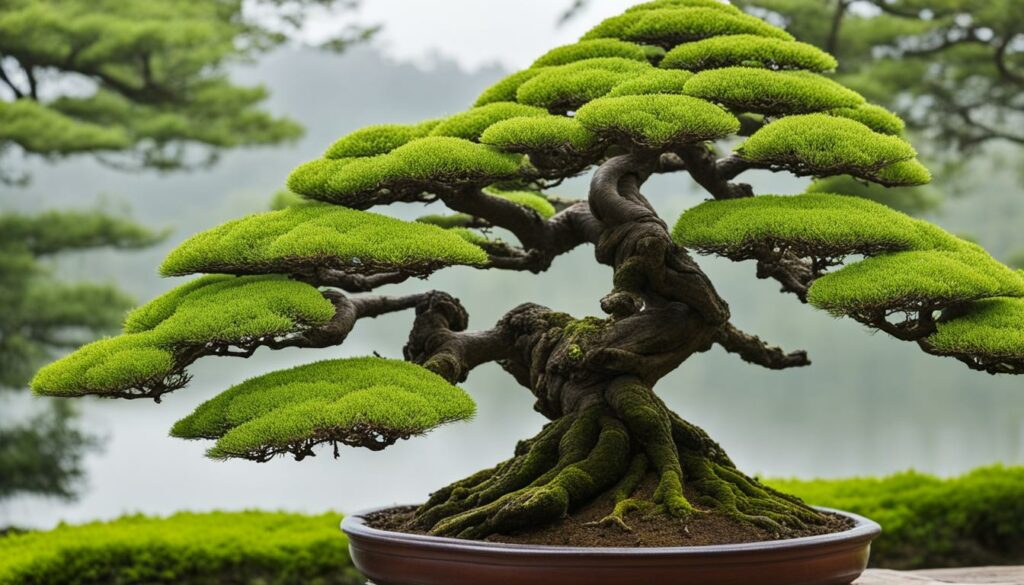
Providing your grafted bonsai trees with the proper care will help ensure their long and healthy life. By following these tips for watering, fertilization, pruning, and pest and disease protection, your grafted bonsai trees will continue to thrive and improve over time.
Troubleshooting Common Grafting Issues
Even the most experienced bonsai cultivators can run into issues during the grafting process. However, with some troubleshooting, you can overcome these challenges and continue to improve your bonsai trees. Here are some common grafting issues and ways to address them:
Failed Grafts
If your graft does not take and the scion fails to grow, it could be due to a variety of factors. One possibility is that the graft was not performed correctly, such as improper scion selection or cut placement. Another factor could be a lack of compatibility between the scion and rootstock.
To troubleshoot failed grafts, identify the potential causes and try adjusting your approach. Consider trying a different grafting technique or selecting a more compatible scion or rootstock.
Graft Rejection
Graft rejection occurs when the scion and rootstock are not compatible, leading to an immune response that causes the graft to fail. This can happen even if all other grafting factors were performed correctly.
If you experience graft rejection, try selecting a more compatible scion and rootstock pairing. Additionally, make sure that your grafting tools are clean and sanitize appropriately to minimize the risk of infection.
Poor Growth or Development
If your grafted bonsai does not show the desired growth or development, it may be due to improper aftercare. Check the water uptake in your bonsai, check for the pests, and make sure that the aftercare practices are appropriate for your specific tree species.
Troubleshooting grafting issues is essential to achieving success in bonsai cultivation grafting trees. By identifying and addressing common problems, you can take steps towards improving your bonsai trees and achieving optimal bonsai improvement.
Tips for Successful Bonsai Grafting
To achieve successful bonsai grafting, it is essential to follow expert tips and tricks. Here are some essential strategies you can implement to maximize your results:
Timing Your Grafts
Select the right time for grafting depending on the type of bonsai tree you are working with. For example, for deciduous trees, the best time for grafting is in spring or early summer, while for conifers, the best time is typically early spring.
Selecting the Right Rootstock
The rootstock of your bonsai tree has a critical impact on the success of your grafting. Choose a healthy, vigorous, and compatible rootstock to ensure that your grafting is successful. Research different rootstock options and their compatibility with the scion before making your selection.
Practicing Good Grafting Technique
Having good grafting skills is essential for achieving successful bonsai grafting. Ensure that your tools are sharp and clean, and practice using different grafting techniques before grafting your bonsai tree. Remember to make precise and clean cuts during the grafting process, using the appropriate grafting method for your particular bonsai tree.
Providing Good Post-Grafting Care
After grafting your bonsai, it is crucial to provide good post-grafting care. Watering your bonsai correctly and regularly, and avoiding any unnecessary stress on the tree are key factors. Protect your freshly grafted tree from direct sunlight, verify the humidity of the soil, and apply the appropriate fertilizers to ensure optimal growth.
By following these expert tips, you can achieve successful bonsai grafting and enhance the growth and aesthetics of your bonsai trees.
Experimenting with Bonsai Grafting
Once you have mastered the basic and advanced techniques in bonsai cultivation grafting trees, you can experiment with different grafting methods and combinations. This is where your creativity can take flight, and you can explore the infinite possibilities of creating unique and stunning bonsai specimens.
Try experimenting with different species combinations to achieve different colors, textures, and foliage types. For instance, grafting coniferous and deciduous trees can produce striking results. Don’t be afraid to try new grafting methods such as approach grafting or inarch grafting.
Remember to keep detailed records of your experiments, including grafting dates, techniques used, and progress, for future reference. You can also share your results with other bonsai enthusiasts and learn from their experiences.
Example of a Grafting Experiment Table
| Grafting Method | Species Combination | Results |
|---|---|---|
| Whip and tongue grafting | Japanese maple scion on Chinese elm rootstock | Successful graft take with foliage color from Japanese maple and trunk strength from Chinese elm. |
| Thread grafting | Pine scion on juniper rootstock | Scion failed to take, possibly due to incompatible species. |
As you can see, experimenting with different bonsai grafting techniques and combinations can lead to surprising and exquisite results. Give it a try and see what unique specimens you can create!
Maintaining Records of Grafted Bonsai Trees
Grafting is an essential technique in bonsai cultivation that requires patience, skill, and attention to detail. To achieve the best outcomes, it’s important to keep accurate records of your grafting progress and results. By recording essential information, you’ll be able to observe and track the tree’s progress, make informed decisions, and apply the best grafting techniques. Here are some reasons why maintaining records of your grafted bonsai trees is important:
- Tracking Grafting Dates: Recording the dates of your grafting operations is important for monitoring the tree’s growth and identifying patterns and trends. Grafting dates can help you make informed decisions about fertilization, watering, and pest control.
- Technical Details and Techniques Used: Record the techniques applied during the grafting process, such as whip and tongue grafting, approach grafting, or thread grafting. This will help you compare and contrast techniques and identify which ones work best for specific bonsai species.
- Growth and Development Progress: Record the development of every grafted tree, including rootstock and scion’s growth, prune development, branch density, and foliage. This information can help you know what procedure to undertake if a particular tree is not developing as expected.
Keeping records of your bonsai trees is easy and straightforward. You can use a notebook, spreadsheet, or a mobile app to keep track of this information. Regular updates of your records help to keep data accurate, allowing you to make well-informed decisions.
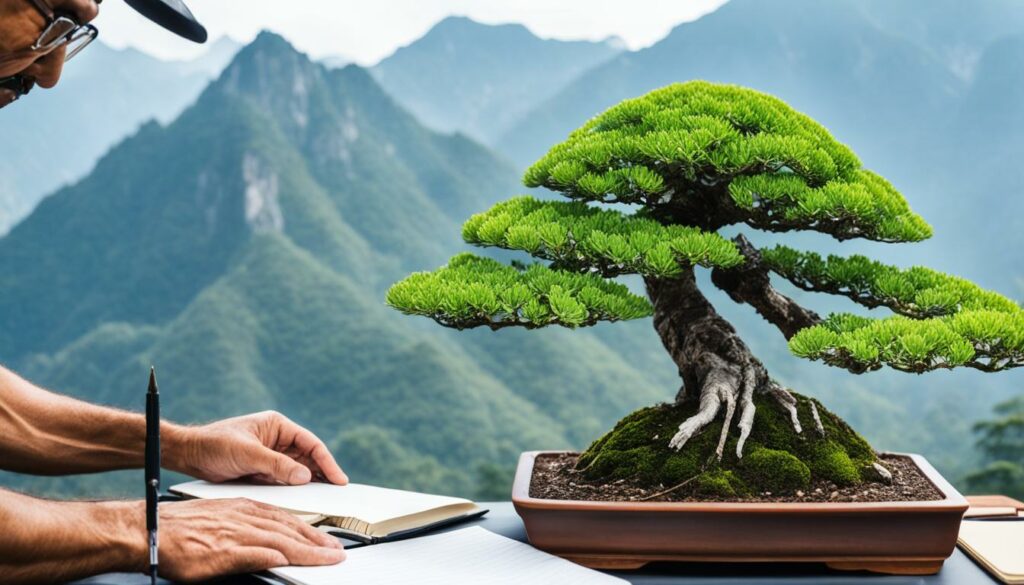
The image above is an example of how to manage your grafted bonsai trees easily. Keeping these records will help you document and keep track of vital information about your bonsai trees, such as grafting dates, techniques used, the growth and development of your trees, and other critical details.
Conclusion
Now that you have learned the art of bonsai cultivation grafting trees, you are ready to enhance your bonsai and take it to the next level. By using the right tools, techniques, and species for grafting, you can improve the overall health, aesthetics, and quality of your bonsai. Remember to maintain accurate records of your grafted bonsai trees to track their progress and make any necessary adjustments.
With your newly acquired grafting skills, you can experiment with different techniques and combinations to create unique and stunning bonsai specimens. Keep in mind the care requirements for grafted bonsai trees, such as proper watering, fertilization, and maintenance, to ensure their longevity.
By mastering bonsai grafting methods, you can unlock a world of possibilities for bonsai improvement and take pride in nurturing your very own beautiful and unique bonsai creations.
FAQ
What is bonsai grafting?
Bonsai grafting is a technique used in bonsai cultivation to join two different trees or branches together. It involves cutting a section of the desired tree and attaching it to another tree or branch, allowing the tissues to fuse and grow together. This technique is commonly used to improve the growth, aesthetics, and characteristics of bonsai trees.
What are the different grafting techniques used in bonsai?
There are several grafting techniques used in bonsai, including side grafting, whip and tongue grafting, approach grafting, thread grafting, bud grafting, and double grafting. Each technique has its own purpose and is used to achieve specific desired results.
What are the benefits of bonsai grafting?
Bonsai grafting offers several benefits. It can lead to improved tree health, increased branch density, enhanced aesthetics, and the creation of unique bonsai specimens. Grafting also allows for the development of specific tree characteristics, such as dwarfing or changing the leaf size and shape.
What tools are essential for bonsai grafting?
Some essential tools for bonsai grafting include grafting knives, grafting tape or bands, pruning shears, root hook, wire cutters, and sealants. These tools are necessary for performing grafting techniques accurately and ensuring successful fusion and healing of the grafted trees.
How do I select the right bonsai species for grafting?
When selecting a bonsai species for grafting, it is important to consider compatibility factors, such as the cambium layer thickness, growth habit, and vigor of the trees involved. Compatibility between the rootstock and the scion is crucial for successful grafting and long-term tree health.
What preparations should I make before bonsai grafting?
Before undertaking the grafting process, it is essential to prepare the bonsai by pruning the branches, creating optimal growing conditions, and ensuring the tree is healthy and free from pests and diseases. Proper preparation sets the stage for successful grafting and promotes the healing and growth of the grafted trees.
What are some basic bonsai grafting techniques?
Basic bonsai grafting techniques include side grafting, whip and tongue grafting, and approach grafting. These techniques involve cutting and joining tree sections, ensuring proper alignment, and securing them to promote fusion and healing.
Are there advanced bonsai grafting techniques?
Yes, there are advanced bonsai grafting techniques, such as thread grafting, bud grafting, and double grafting. These techniques require more skill and precision but offer greater control over the tree’s development and aesthetics.
How do I care for grafted bonsai trees?
Grafted bonsai trees require specific care, including proper watering, fertilization, and maintenance. It is important to provide the right amount of water, nutrients, and light for the grafted trees to thrive and ensure their long-term health and vitality.
What are some common grafting issues in bonsai and how can I troubleshoot them?
Common grafting issues in bonsai include failed grafts and graft rejection. To troubleshoot these issues, it is important to identify the underlying causes, such as poor compatibility or improper grafting techniques. Making sure to follow proper grafting procedures and addressing any compatibility issues can help overcome these challenges.
What are some tips for successful bonsai grafting?
To achieve successful bonsai grafting, it is important to choose the right timing for grafting, select suitable rootstock and scion, and ensure a good match between the two. Paying attention to detail, using clean and sharp tools, and keeping records of your grafting techniques can also contribute to success.
Can I experiment with different bonsai grafting techniques?
Yes, experimenting with different bonsai grafting techniques can expand your knowledge and creativity. By trying out different combinations and techniques, you can create unique and stunning bonsai specimens and further develop your grafting skills.
Why is it important to maintain records of grafted bonsai trees?
Maintaining accurate records of your grafted bonsai trees allows you to track their development progress, grafting dates, techniques used, and any changes observed. This valuable information can guide future grafting decisions and help you learn from your experiences.
